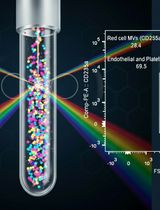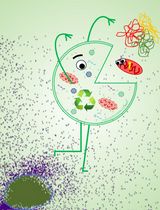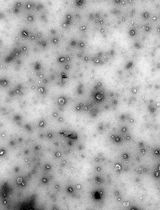- EN - English
- CN - 中文
Isolation and Characterization of Extracellular Vesicles Derived from Ex Vivo Culture of Visceral Adipose Tissue
从离体培养的内脏脂肪组织中分离和鉴定细胞外囊泡
发布: 2024年06月05日第14卷第11期 DOI: 10.21769/BioProtoc.5011 浏览次数: 2131
评审: Xinlei LiAnonymous reviewer(s)

相关实验方案

外周血中细胞外囊泡的分离与分析方法:红细胞、内皮细胞及血小板来源的细胞外囊泡
Bhawani Yasassri Alvitigala [...] Lallindra Viranjan Gooneratne
2025年11月05日 1328 阅读
Abstract
Extracellular vesicles (EVs) are a heterogeneous group of nanoparticles possessing a lipid bilayer membrane that plays a significant role in intercellular communication by transferring their cargoes, consisting of peptides, proteins, fatty acids, DNA, and RNA, to receiver cells. Isolation of EVs is cumbersome and time-consuming due to their nano size and the co-isolation of small molecules along with EVs. This is why current protocols for the isolation of EVs are unable to provide high purity. So far, studies have focused on EVs derived from cell supernatants or body fluids but are associated with a number of limitations. Cell lines with a high passage number cannot be considered as representative of the original cell type, and EVs isolated from those can present distinct properties and characteristics. Additionally, cultured cells only have a single cell type and do not possess any cellular interactions with other types of cells, which normally exist in the tissue microenvironment. Therefore, studies involving the direct EVs isolation from whole tissues can provide a better understanding of intercellular communication in vivo. This underscores the critical need to standardize and optimize protocols for isolating and characterizing EVs from tissues. We have developed a differential centrifugation-based technique to isolate and characterize EVs from whole adipose tissue, which can be potentially applied to other types of tissues. This may help us to better understand the role of EVs in the tissue microenvironment in both diseased and normal conditions.
Key features
• Isolation of tissue-derived extracellular vesicles from ex vivo culture of visceral adipose tissue or any whole tissue.
• Microscopic visualization of extracellular vesicles’ morphology without dehydration steps, with minimum effect on their shape.
• Flow cytometry approach to characterize the extracellular vesicles using specific protein markers, as an alternative to the time-consuming western blot.
Keywords: Extracellular vesicles (细胞外囊泡)Background
Extracellular vesicles (EVs) are nanoparticles possessing a lipid bilayer membrane that participate in intercellular communication by transferring encoded information and cargo molecules in the form of lipids, cytokines, RNA, DNA, proteins, peptides, and other biomolecules to the recipient cells [1]. Despite considerable progress, the challenges and complexity associated with EVs remain substantial. The isolation of EVs is frequently complicated by the presence of other extracellular macromolecules with similar features [2]. There are three main subtypes of EVs distinguished by their respective sources: body fluids, cell culture, and tissues [3].
Most of the studies have been accomplished on EVs derived from cell culture supernatants or body fluids, such as serum, plasma, whole blood, milk, saliva, and urine [3]. However, several drawbacks are associated with cell culture and body fluid–derived EVs related studies.
Cell culture supernatant-derived EVs can be considered as a reliable source for mechanistic studies due to the continuous availability and reproducibility of results. Cultured cells lose their unique features after long-term subcultures, affecting the quality and composition of the EVs released, thereby altering the interpretation of EVs biological function [4]. Moreover, cells are mostly cultured in a two-dimensional environment with single-cell type and no heterogenic cell–cell interactions that exist in the tissue microenvironment [4,5]. Therefore, cell culture–derived EVs cannot reflect the exact dynamic progression of the disease. Body fluid–derived EVs provide a minimally invasive method to imitate the dynamic development of diseases [6,7]. However, mixtures of EVs from various sources are included in body fluids, comprising serum-derived proteins [8]. Also, it is difficult to identify the exact tissue of origin from where the EVs are isolated [9]. Therefore, it is required to focus on the studies involving tissue-derived EVs from whole tissues so as to generate a better understanding; unfortunately, the number of related studies are limited, with existing isolation and characterization protocols primarily tailored to the former subtypes.
Tissue-derived EVs, residing in the extracellular interstitium, serve as integral mediators of intercellular signal transduction, providing the exact pathophysiological state and interactions between different types of cells, demonstrating the 3D structure and cell properties [5,10]. Notably, tissue-derived EVs overcome challenges associated with contaminants found in body fluid–derived EVs [4]. Analyzing EVs from tumor and adjacent non-tumor tissues provides valuable insights into their common biological properties [8].
Recognizing this gap, we present a robust and reproducible method for isolating and characterizing tissue-derived EVs, specifically from adipose tissue comprising of a heterogeneous population of cells that cooperate to perform multiple physiological roles. Adipose tissue dysfunction, usually observed in obesity, is linked to changes in the adipose secretome comprised of cytokines, free fatty acids, hormones, lipids, and, more lately, extracellular vesicles, which subsequently contribute to the disease pathology [11]. We have developed a simple, reliable, and reproducible method to isolate and characterize tissue-derived extracellular vesicles. We highly recommend further studies on tissue-derived EVs, as it can support a better understanding of the tissue microenvironment in normal and in diseased conditions.
Materials and reagents
Biological materials
Human visceral adipose tissue
Note: Peri-pancreatic adipose tissue (adipose tissue in the retroperitoneum region surrounding the pancreas) is used as biological experimental material in this protocol. Peri-pancreatic adipose tissue has been taken from human subjects undergoing pancreatic cancer surgery after written informed consent. However, the protocol can be used with any type of tissue.
The study has been approved by the Institutional Ethics Committee (INT/IEC/2023/SPL-287, 21st March, 2023) of Post Graduate Institute of Medical Education and Research, Chandigarh, India.
Reagents
Distilled water
10× Dulbecco’s phosphate buffered saline (DPBS) (HIMEDIA, catalog number: TL1022). Store at 15–30 °C
Antibiotic–Antimycotic cocktail (GibcoTM, catalog number: 15240-062)
Exosome-depleted FBS (GibcoTM, catalo number: A2720801)
HiAdipo XLTM adipocyte differentiation media (HIMEDIA, catalog number: AL521)
Part A: Basal medium (store at 2–8 °C)
Part B: Differentiation supplement (store at -5 to -20 °C)
For complete medium: Add the contents of Part B to Part A under aseptic conditions with 1 mL of antibiotic cocktail solution and 10% exosome-depleted FBS
PierceTM BCA Protein Assay kit (Thermo Scientific, catalog number: 23227)
RIPA (EMD Millipore, catalog number: 20-188)
Protease inhibitor cocktail (Sigma, catalog number: P8340)
Sodium dihydro orthophosphate anhydrous (Sigma, catalog number: 5438400100)
Sucrose (Sigma, catalog number: S0389)
Sodium hydroxide (Sigma, catalog number: 1.06498)
Uranyl acetate dihydrate (SRL laboratories, catalog number: 81405)
25% glutaraldehyde EM grade (Electron Microscopy Sciences, catalog number: 16220)
30% Acrylamide-bisacrylamide solution (HIMEDIA, catalogue number: ML037)
Tris base (HIMEDIA, catalog number: TC072M)
Sodium do-decyl sulphate (SDS) (HIMEDIA, catalog number: GRM205)
Glycine (HIMEDIA, catalog number: MB013)
Sodium chloride (NaCl) (HIMEDIA, catalog number: GRM3954)
Bovine serum albumin (BSA) (HIMEDIA, catalog number: MB083)
Tween 20 (Sigma, catalog number: P9416)
Ponceau S (HIMEDIA, catalog number: ML045)
Glacial acetic acid (Central drug house, product code: 027017)
2- propanol (HIMEDIA, catalog number: MB063)
Glycerol (HIMEDIA, catalog number: MB060)
Bromophenol blue (Sigma, catalog number: 114391)
β-mercaptoethanol (Sigma, catalog number: 6250)
Methanol LR (SDFCL limited, product code: 39192)
Ammonium persulphate (APS) (HIMEDIA, catalog number: MB003)
N, N, N’, N’,-Tetramethyl ethylenediamine (TEMED) (Sigma, catalog number: T9281)
Clarity Western ECL substrate (Bio-Rad, catalog number: 170-5061)
Pre-stained protein ladder (HIMEDIA, catalog number: MBT092)
Coomassie® brilliant blue (HIMEDIA, catalog number: MB092)
Primary and secondary antibodies for Western blotting (Table 1)
Table 1. Primary and secondary antibodies
Antibody Host Company Catalog number CD 63 (clone: E1W3T) Rabbit mAb Cell Signaling Technology 52090 CD 9 (clone: D8O1A) Rabbit mAb Cell Signaling Technology 13174 TSG 101 (clone: E6V1X) Rabbit mAb Cell Signaling Technology 72312 Calnexin Rabbit pAb Cell Signaling Technology 2433 Anti-Rabbit-HRP Goat IgG Abcam ab97051 CD 9 exosome capture beads (Abcam, catalog number: ab239685)
CD 63 exosome capture beads (Abcam, catalog number: ab239686)
Conjugated antibodies for flow cytometry (Table 2)
Table 2. Conjugated antibodies
Antibody-Fluorochrome Host Company Catalog number CD 63-FITC (clone: H5C6) Mouse mAb BioLegend 353005 CD 9-PE (clone: HI9A) Mouse mAb BioLegend 312105
Solutions
1× Dulbecco’s phosphate buffered saline (DPBS) (see Recipes)
1× RIPA buffer (see Recipes)
BCA working solution (see Recipes)
Sorensen’s phosphate buffer (see Recipes)
3% Glutaraldehyde (see Recipes)
5% Uranyl acetate (see Recipes)
10× Electrophoresis running buffer (see Recipes)
1× Electrophoresis running buffer (see Recipes)
Transfer buffer (see Recipes)
1.0 M Tris-HCl, pH 6.8 (see Recipes)
1.5 M Tris-HCl, pH 8.8 (see Recipes)
10% SDS (see Recipes)
10% APS (see Recipes)
10% SDS-PAGE resolving gel (see Recipes)
12% SDS-PAGE resolving gel (see Recipes)
15% SDS-PAGE stacking gel (see Recipes)
6× Loading dye (Laemmli buffer) (see Recipes)
Working loading dye (reducing) (see Recipes)
CBB staining solution (see Recipes)
10× TBS (see Recipes)
1× TBST (see Recipes)
5% BSA Blocking Buffer (see Recipes)
Recipes
Note: All the solutions are kept under room temperature unless described. Always refer to the manufacturer’s instructions for the storage temperature and shelf life of reagent.
1× DPBS
Reagent Final concentration Amount 10× DPBS 10× 5 mL Distilled water n/a 45 mL 1× RIPA Buffer
Reagent Final concentration Amount 10× RIPA n/a 100 μL Distilled water n/a 900 μL Protease inhibitor n/a 2 μL BCA working solution
Reagent Final concentration Amount Part A n/a 50 mL Part B n/a 1 mL This solution is stable for 1 day only. Prepare just before use. Working solution quantity will vary upon the requirement and the number of samples. The ratio of part A and part B should be 50:1.
Sorensen’s phosphate buffer
Reagent Final concentration Amount Sodium dihydro orthophosphate n/a 1.9 g Sodium hydroxide n/a 0.28 g (≈ 2 pellets) Distilled water n/a 400 mL 3% Glutaraldehyde
Reagent Final concentration Amount Sorensen’s phosphate buffer n/a 400 mL Glutaraldehyde 25% 54 mL Sucrose n/a 7.4 g Adjust the pH to 7.2–7.4. Prepare the solution as stock and store at 4 °C for long-term use.
5% uranyl acetate
Reagent Final concentration Amount Uranyl acetate 5% 50 mg Distilled water n/a 1 mL 10× Electrophoresis running buffer
Reagent Final concentration Amount Tris base 25 mM 30 g Glycine 192 mM 144 g SDS 0.1% 10 g Make up the volume to 1,000 mL. Keep at 37 overnight to dissolve completely. Store at 4 for long-term use.
1× Electrophoresis running buffer
Reagent Final concentration Amount 10× electrophoresis running buffer n/a 100 mL Distilled water n/a 900 mL Transfer buffer
Reagent Final concentration Amount Tris base 25 mM 3.0 g Glycine 190 mM 14.2 g Methanol n/a 200 mL Make up the volume to 1,000 mL. Prepare the solution 3–4 h before use so that it can be completely dissolved. The solution needs to be chilled.
1.0 M Tris-HCl
Reagent Final concentration Amount Tris base 1.0 M 6 g Distilled water n/a 70 mL Keep the solution at 37 overnight. Set the pH at 6.8 using concentrated HCl. Make up the final volume to 100 mL. Store at 4 .
1.5 M Tris-HCl
Reagent Final concentration Amount Tris base 1.5 M 18.15 g Distilled water n/a 70 mL Keep the solution at 37 overnight. Set the pH at 8.8 using concentrated HCl. Make up the final volume to 100 mL. Store at 4 .
10% SDS
Reagent Final concentration Amount SDS n/a 10 g Distilled water n/a 100 mL 10% APS
Reagent Final concentration Amount Ammonium persulphate n/a 0.1 g Distilled water n/a 1 mL Freshly prepare the solution every time before use. Keep the APS on ice until use.
10% polyacrylamide resolving gel
Reagent Final concentration Amount Acrylamide-bisacrylamide solution 30% 3.3 mL Tris-HCl 1.5 M 2.5 mL SDS 10% 0.1 mL Distilled water n/a 4.0 mL APS 10% 100 μL TEMED n/a 4 μL 12% polyacrylamide resolving gel
Reagent Final concentration Amount Acrylamide-bisacrylamide solution 30% 4 mL Tris-HCl 1.5 M 2.5 mL SDS 10% 0.1 mL Distilled water n/a 3.3 mL APS 10% 100 μL TEMED n/a 4 μL 5% polyacrylamide stacking gel
Reagent Final concentration Amount Acrylamide-bisacrylamide solution 30% 330 μL Tris-HCl (pH: 6.8) 1.0 M 250 μL SDS 10% 20 μL Distilled water n/a 1.4 mL APS 10% 20 μL TEMED n/a 2 μL 6× Loading dye (Laemmli buffer)
Reagent Final concentration Amount SDS 9% 0.9 g Pure glycerol 50% 5 mL Tris-HCl 375 mM 0.591 g Distilled water n/a 7 mL Dissolve all three items. Set to pH 6.8 using NaOH. Add 0.03 g of bromophenol blue (0.03%). Make up the final volume to 10 mL using distilled water. Store at -20 for long term use.
Working loading dye (reducing)
Reagent Final concentration Amount 6× Loading dye n/a 91 μL β-mercaptoethanol n/a 9 μL Freshly prepare the dye every time before use.
CBB staining solution
Reagent Final concentration Amount Coomassie brilliant blue 0.1% 0.05 g Methanol n/a 20 mL Distilled water n/a 70 mL Glacial acetic acid n/a 10 mL Coomassie brilliant blue is first dissolved in methanol followed by distilled water and acetic acid. Mix thoroughly and store at 4 . This solution can be used several times.
10× TBS
Reagent Final concentration Amount Tris base n/a 24 g NaCl n/a 88 g Distilled water n/a 900 mL Keep the solution at 37 overnight. Set to pH 7.6 using concentrated HCl. Make up the final volume to 1000 mL. Store at 4 for long term use.
1× TBST
Reagent Final concentration Amount 10× TBS n/a 100 mL Distilled water n/a 900 mL Tween 20 0.1% 1 mL Store the solution at 4 .
5% BSA blocking buffer
Reagent Final concentration Amount BSA 5% 2.5 g 1× TBST n/a 50 mL Freshly prepare the solution each time.
Laboratory supplies
FinnpipetteTM F2 Good Laboratory Pipetting (GLP) Kits: 1: 1–10 μL, 10–100 μL, and 100–1000 μL (Thermo ScientificTM, catalog number: 4700870)
1.5 mL micro centrifuge tubes (Tarsons, catalog number: 500010)
96-well plate (Falcons, catalog number: 353072)
15 mL graduated centrifuge tubes, PP (Tarsons, catalog number: 546021)
50 mL graduated centrifuge tubes, PP (Tarsons, catalog number: 546041)
Disposable Petri dishes (Tarsons, catalog number: 460090-90 mm)
Costar® 6-well cell culture plate (Corning Inc, catalog number: 3516)
Sterile surgical blades
Syringe driven filters (HIMEDIA, catalog number: SF-137)
Quartz flow cell cuvette (Malvern, model number: ZEN0023)
Type 90 Ti fixed-angle titanium rotor (Beckmann Coulter, product number: 355530)
Quick-seal tube kit, 16 × 76 mm (Beckmann Coulter, product number: 348179)
Coverslips
Copper grid, carbon coated, Type B 200 mesh (TED Pella USA, model number: 01810)
Tweezer, high precision, Style 5 (Electron Microscopy Sciences, catalog number: 78325-5S)
Blotting sheets
Nitrocellulose transfer membrane 0.45 μm (HIMEDIA, catalog number: SF110B)
Polystyrene round-bottom tube 12 × 75 mm style (Falcon, catalog number: 352054)
Equipment
Airstream® Class II Type A2 biological safety cabinet (ESCO Scientific, catalog number: 2011011)
Centrifuge 5430-R with rotor F-35-6-30 (Eppendorf, catalog number: 022620659)
Ultra-sonic bath sonicator (LABWAN, model: LW-USB11)
Optima XPN 100 ultracentrifuge (Beckmann coulter, model: OPTIMA XPN-100)
Zetasizer Nano ZSP (Malvern, model: MEL0665)
JSM-IT300 InTouchScopeTM scanning electron microscope (JEOL, model: JSM-IT300)
JEOL-1400 plus Transmission electron microscope (JEOL, model: JEOL 1400 plus)
Mini-PROTEAN® TETRA CELL (Bio-Rad, catalog number: 1658004)
Mini-PROTEAN® TETRA CELL Single core (Bio-Rad, catalog number: 1658005)
PROTEAN® System casting stand (Bio-Rad, catalog number: 1658050)
Mini-PROTEAN® TETRA cell handcasting accessory kit (Bio-Rad, catalog number: 1653370)
Mini-PROTEAN® system glass plates (Bio-Rad, catalog number: 1653308)
Mini-PROTEAN® Gel releasers (Bio-Rad, catalog number: 1653320)
Mini-PROTEAN® gaskets (Bio-Rad, catalog number: 1653305)
Mini-PROTEAN® comb, 10 well (Bio-Rad, catalog number: 1653359)
Mini-TRANS-BLOT® electrophoretic transfer cell (Bio-Rad, catalog number: 1703930)
Mini-TRANS-BLOT® foam pads (Bio-Rad, catalog number: 1703933)
Mini-TRANS-BLOT® accessories (Bio-Rad, catalog number: 1703820)
Rocking shaker (Dot Scientific Inc, catalog number: SK-R1807-S)
Azure 400® imager (Azure Biosystems, model number: AZURE 400)
BD FACS Canto II flow cytometer (BD Biosciences, model: BD FACS CantoTM II)
Procedure
文章信息
版权信息
© 2024 The Author(s); This is an open access article under the CC BY-NC license (https://creativecommons.org/licenses/by-nc/4.0/).
如何引用
Arora, A., Sharma, V., Gupta, R. and Aggarwal, A. (2024). Isolation and Characterization of Extracellular Vesicles Derived from Ex Vivo Culture of Visceral Adipose Tissue. Bio-protocol 14(11): e5011. DOI: 10.21769/BioProtoc.5011.
分类
细胞生物学 > 细胞器分离 > 胞外囊泡
细胞生物学 > 基于细胞的分析方法 > 流式细胞术
您对这篇实验方法有问题吗?
在此处发布您的问题,我们将邀请本文作者来回答。同时,我们会将您的问题发布到Bio-protocol Exchange,以便寻求社区成员的帮助。
Share
Bluesky
X
Copy link











